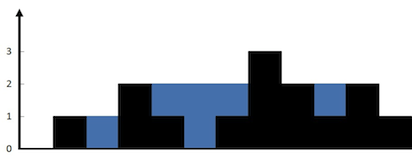Given n non-negative integers representing an elevation map where the width of each bar is 1, compute how much water it can trap after raining.
Example 1:

Input: height = [0,1,0,2,1,0,1,3,2,1,2,1]
Output: 6
Explanation: The above elevation map (black section) is represented by array [0,1,0,2,1,0,1,3,2,1,2,1]. In this case, 6 units of rain water (blue section) are being trapped.
Example 2:
Input: height = [4,2,0,3,2,5]
Output: 9
Constraints:
n == height.length1 <= n <= 2 * 1040 <= height[i] <= 105
1. Increment the left position until we find the left element greater than right.
2. Water can only be trapped in the heigh[i] if the maxHeight is greater than height[i].
class Solution {
public:
int trap(vector<int>& height) {
int left = 0, right = height.size()-1;
int maxLeft = 0, maxRight = 0, res = 0;
while (left < right) {
if (height[left] <= height[right]) {
if (height[left] <= maxLeft) {
// Trap the water
res += maxLeft - height[left];
}
maxLeft = max(maxLeft, height[left]);
left++;
} else {
if (height[right] <= maxRight) {
// Trap the water
res += maxRight - height[right];
}
maxRight = max(maxRight, height[right]);
right--;
}
}
return res;
}
};Similar problem : Container with most water
Comments
Post a Comment